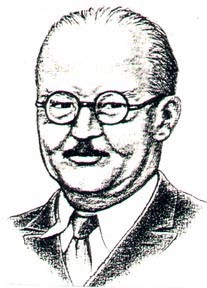Early Mushroom Finders – Reko, Weitlaner, Shultes
Late 1930’s when they were once again brought to the attention of the scientific community.
 |
|
Fig. 1. Dr. Blas Pablo Reko
Drawn by E.W. Smith |
In the second decade of this century, Austrian Blas Pablo Reko – Links to an external site. (1919), a physician with an interest in ethnobotany, learned that some groups of Indians living in the Mexican state of Oaxaca were still using psychoptic mushrooms in secret ceremonies perhaps involving ancient rites. These rites were performed apparently for the purpose of divinatory healing. Reko published his findings in a journal entitled El México Antiguo.
Reko subsequently discussed this discovery with his colleagues, who paid little attention to his mushroomic theories and showed no interest in pursuing this information on the supposititious use of inebriating mushrooms by the Indians of Mesoamérica. Reko wrote that teonanácatl was “Div. géneros de hongos, especialmente un hongo negro que crece sobre estiércol y produce efectos narcóticos.” [“Various genera of mushrooms, especially a black mushroom that grows on dung and produces psychotropic effects”].
Reko – Links to an external site. (1923) later wrote to Dr. J. N. Rose of the United States National Herbarium that “I see in your description of Lophorphora (peyote) that Dr. Safford believes this plant to be the `teonanácatl‘ of Sahagún which is surely wrong. It is actually as Sahagún states, a fungus which grows on dung heaps and which is still used under the same old name by the Indians of the Sierra Juarez in Oaxaca in their religious feasts.” Safford’s last defender, Huntington Cairns – Links to an external site. (1929), became the last person to expound the Safford theory.
B. P. Reko’s cousin, Victor A. Reko – Links to an external site. (1928), published the first objection to Safford’s claims. It appeared in a book written years later in 1936. Below is an excerpt describing the effects of the mushrooms taken from that book entitled Magische Gifte: Rausche und Betäubungsmittel der Neuen Welt (“Magical Poisons: inebrients and Narcotics of the New World“):
“The nanacates are poisonous mushrooms which have nothing to do with peyote. It is known from olden times that their use induces intoxication, states of ecstacy and mental aberrations, but, notwithstanding the dangers attendant upon their use, people everywhere they grow take advantage of their intoxicating properties up to the present time.”
In 1936, an Austrian engineer, Roberto J. Weitlaner, who was also an avid ethnobotanist, spent four days in Huautla de Jiménez, Oaxaca, where he was engaged in linguistic investigations. Weitlaner had learned of the existence of the sacred mushrooms from a Mazatec merchant named José Dorantes. Dorantes had described to Weitlaner his reactions after eating three of the mushrooms which were given to him during a divinatory healing (Johnson – Links to an external site. 1940). It was Weitlaner who first realized that these sacred mushrooms were most likely the teonanácatl described in the chronicles of the Spanish clerics. During this period, several mushroom specimens were collected and forwarded to Blas Pablo Reko. Reko in turn sent the specimens to Harvard University for botanical identification. However, the specimens spoiled before they arrived, thus further delaying their identification and proof of their existence to the scientific community.
In 1936, Weitlaner became the first white man in modern times to observe an actual sacred mushroom ceremony. Two years later, in 1938, his daughter Irmgard, her fiancé Jean Basset Johnson and two friends (Louise Lacaud and Bernard Bevan) continued the investigations begun by Weitlaner. These intrepid investigators were not only able to gather a considerable amount of data on Mazatec shamanism and the use of the sacred mushrooms, but in the process became the first westerners to witness a Mesoamérica shamanic mushroom ceremony. The velada was held in a hut in the tiny montane village of Huautla de Jiménez. Johnson – Links to an external site. (1939a) published two startling papers regarding his observations on Mazatec “witchcraft.” Furthermore, while in Oaxaca, these investigators met Dr. Richard Evans Schultes and Dr. Blas Pablo Reko who were also in Huautla collecting ethnomycological data and mushroom specimens.
In 1936, Schultes was just another premedical undergraduate student at Harvard University and one of his classes was Biology 104. While attending a course on “Plants and Human Affairs”, Schultes was assigned to read a book by Heinrich Klüver – Links to an external site. entitled “Mescal: The Divine Plant and its Psychological Effects.” Unbeknownst to Schultes, this assignment was destined to change the course of his entire life.
The collecting of teonanácatl mushrooms took place when a young Harvard botanist, Richard Evans Schultes, made a trip to Huautla de Jiménez with Blas Pablo Reko (Schultes – Links to an external site. Pers. Comm. 1989) and collected several specimens of mushrooms which were suspected of being used in “magico-religious ceremonies.” After sun-drying several specimens of these mushrooms, they mailed these samples to Harvard University for identification.